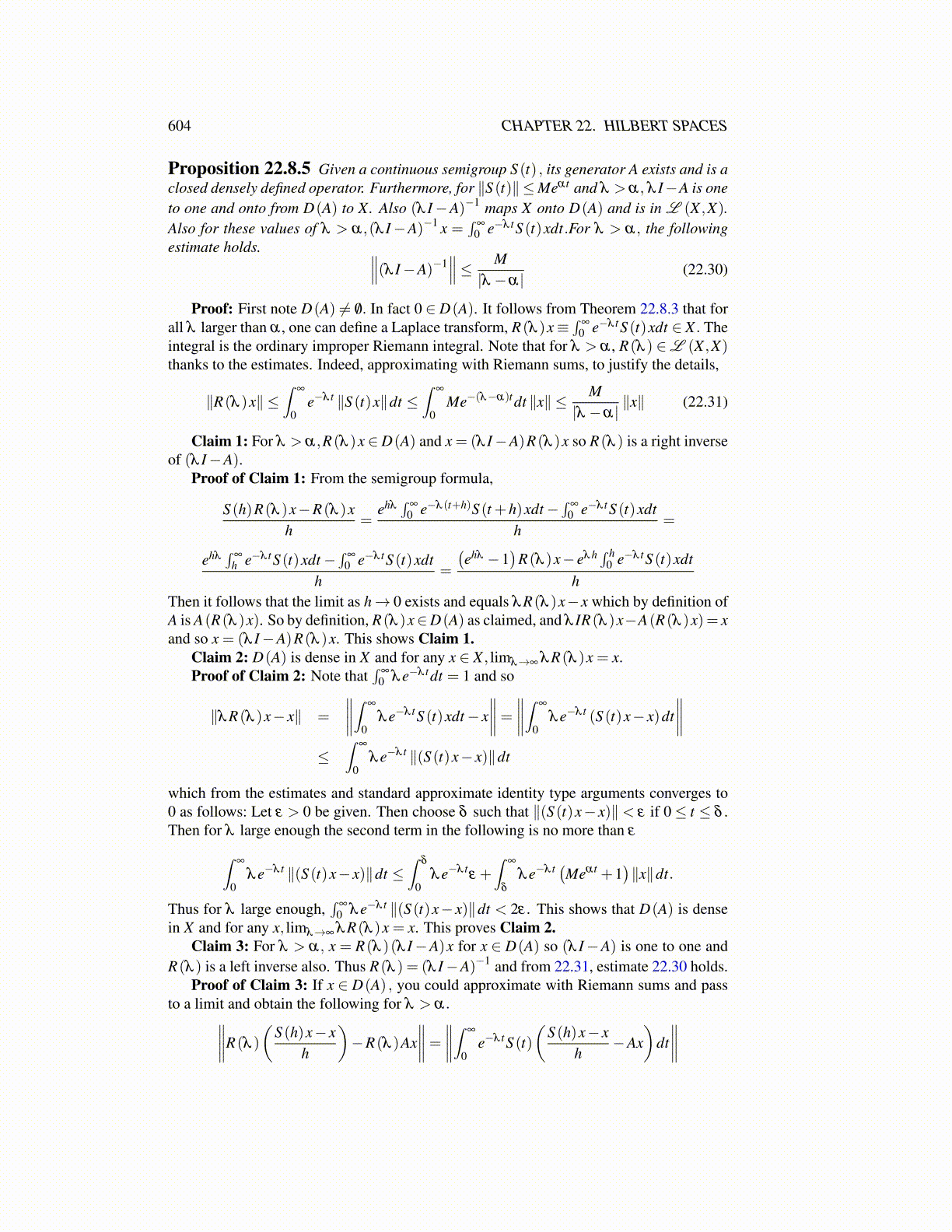
604 CHAPTER 22. HILBERT SPACES
Proposition 22.8.5 Given a continuous semigroup S (t) , its generator A exists and is aclosed densely defined operator. Furthermore, for ∥S (t)∥≤Meαt and λ > α, λ I−A is oneto one and onto from D(A) to X. Also (λ I−A)−1 maps X onto D(A) and is in L (X ,X).Also for these values of λ > α,(λ I−A)−1 x =
∫∞
0 e−λ tS (t)xdt.For λ > α, the followingestimate holds. ∥∥∥(λ I−A)−1
∥∥∥≤ M|λ −α|
(22.30)
Proof: First note D(A) ̸= /0. In fact 0 ∈ D(A). It follows from Theorem 22.8.3 that forall λ larger than α , one can define a Laplace transform, R(λ )x≡
∫∞
0 e−λ tS (t)xdt ∈ X . Theintegral is the ordinary improper Riemann integral. Note that for λ > α , R(λ ) ∈L (X ,X)thanks to the estimates. Indeed, approximating with Riemann sums, to justify the details,
∥R(λ )x∥ ≤∫
∞
0e−λ t ∥S (t)x∥dt ≤
∫∞
0Me−(λ−α)tdt ∥x∥ ≤ M
|λ −α|∥x∥ (22.31)
Claim 1: For λ > α,R(λ )x ∈D(A) and x = (λ I−A)R(λ )x so R(λ ) is a right inverseof (λ I−A).
Proof of Claim 1: From the semigroup formula,
S (h)R(λ )x−R(λ )xh
=ehλ
∫∞
0 e−λ (t+h)S (t +h)xdt−∫
∞
0 e−λ tS (t)xdth
=
ehλ∫
∞
h e−λ tS (t)xdt−∫
∞
0 e−λ tS (t)xdth
=
(ehλ −1
)R(λ )x− eλh ∫ h
0 e−λ tS (t)xdth
Then it follows that the limit as h→ 0 exists and equals λR(λ )x−x which by definition ofA is A(R(λ )x). So by definition, R(λ )x∈D(A) as claimed, and λ IR(λ )x−A(R(λ )x)= xand so x = (λ I−A)R(λ )x. This shows Claim 1.
Claim 2: D(A) is dense in X and for any x ∈ X , limλ→∞ λR(λ )x = x.Proof of Claim 2: Note that
∫∞
0 λe−λ tdt = 1 and so
∥λR(λ )x− x∥ =
∥∥∥∥∫ ∞
0λe−λ tS (t)xdt− x
∥∥∥∥= ∥∥∥∥∫ ∞
0λe−λ t (S (t)x− x)dt
∥∥∥∥≤
∫∞
0λe−λ t ∥(S (t)x− x)∥dt
which from the estimates and standard approximate identity type arguments converges to0 as follows: Let ε > 0 be given. Then choose δ such that ∥(S (t)x− x)∥< ε if 0≤ t ≤ δ .Then for λ large enough the second term in the following is no more than ε∫
∞
0λe−λ t ∥(S (t)x− x)∥dt ≤
∫δ
0λe−λ t
ε +∫
∞
δ
λe−λ t (Meαt +1)∥x∥dt.
Thus for λ large enough,∫
∞
0 λe−λ t ∥(S (t)x− x)∥dt < 2ε . This shows that D(A) is densein X and for any x, limλ→∞ λR(λ )x = x. This proves Claim 2.
Claim 3: For λ > α, x = R(λ )(λ I−A)x for x ∈ D(A) so (λ I−A) is one to one andR(λ ) is a left inverse also. Thus R(λ ) = (λ I−A)−1 and from 22.31, estimate 22.30 holds.
Proof of Claim 3: If x ∈ D(A) , you could approximate with Riemann sums and passto a limit and obtain the following for λ > α.∥∥∥∥R(λ )
(S (h)x− x
h
)−R(λ )Ax
∥∥∥∥= ∥∥∥∥∫ ∞
0e−λ tS (t)
(S (h)x− x
h−Ax
)dt∥∥∥∥